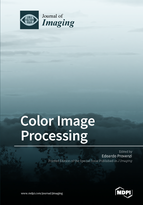Color Image Processing
A special issue of Journal of Imaging (ISSN 2313-433X).
Deadline for manuscript submissions: closed (30 June 2017) | Viewed by 98621
Special Issue Editor
Interests: color image processing; variational principles; geometry of color spaces; high dynamic range imaging; statistics of natural images; contrast measures; multispectral imaging; color in art and science
Special Issue Information
Dear Colleagues,
Color is one of the most important and fascinating attributes of the natural environment. Research about color is becoming more and more prevalent in image processing and computer vision, even if many models are still designed for grayscale pictures and their extension to color images is not a trivial task. In fact, the intrinsic multidisciplinary character of color makes it difficult to model, both from a perceptual and a computational or mathematical level.
The intent of this Special Issue is to provide a framework where scientists in several different disciplines related to color can find a place to illustrate their ideas and results.
This Special Issue is primarily focused on the following topics, however we encourage all submissions related to color in imaging:
- Computational color vision models
- Perceptually-inspired color image and video processing
- Variational and patch-based techniques applied to color images
- Color data compression and encoding
- Color image/video indexing and retrieval
- Color enhancement
- Color constancy and saliency
- Color texture
- Color image and video watermarking
- Color image/video quality assessment
- Multispectral imaging
- Geometry of color spaces
- Interactions between color science and other disciplines such as art, medicine, psychology, and so on
- Color imaging and technology for material appearance
- Color and contrast measures
- Statistics of natural images in color
- High dynamic range imaging in color
Prof. Dr. Edoardo Provenzi
Guest Editor
Manuscript Submission Information
Manuscripts should be submitted online at www.mdpi.com by registering and logging in to this website. Once you are registered, click here to go to the submission form. Manuscripts can be submitted until the deadline. All submissions that pass pre-check are peer-reviewed. Accepted papers will be published continuously in the journal (as soon as accepted) and will be listed together on the special issue website. Research articles, review articles as well as short communications are invited. For planned papers, a title and short abstract (about 100 words) can be sent to the Editorial Office for announcement on this website.
Submitted manuscripts should not have been published previously, nor be under consideration for publication elsewhere (except conference proceedings papers). All manuscripts are thoroughly refereed through a single-blind peer-review process. A guide for authors and other relevant information for submission of manuscripts is available on the Instructions for Authors page. Journal of Imaging is an international peer-reviewed open access monthly journal published by MDPI.
Please visit the Instructions for Authors page before submitting a manuscript. The Article Processing Charge (APC) for publication in this open access journal is 1800 CHF (Swiss Francs). Submitted papers should be well formatted and use good English. Authors may use MDPI's English editing service prior to publication or during author revisions.
Keywords
- Color image processing
- Spatial models of color vision
- Color in art, psychology, medicine
- Color imaging and technology for material appearance
- Geometry of color spaces
- Color image/video quality assessment
- High dynamic range imaging







